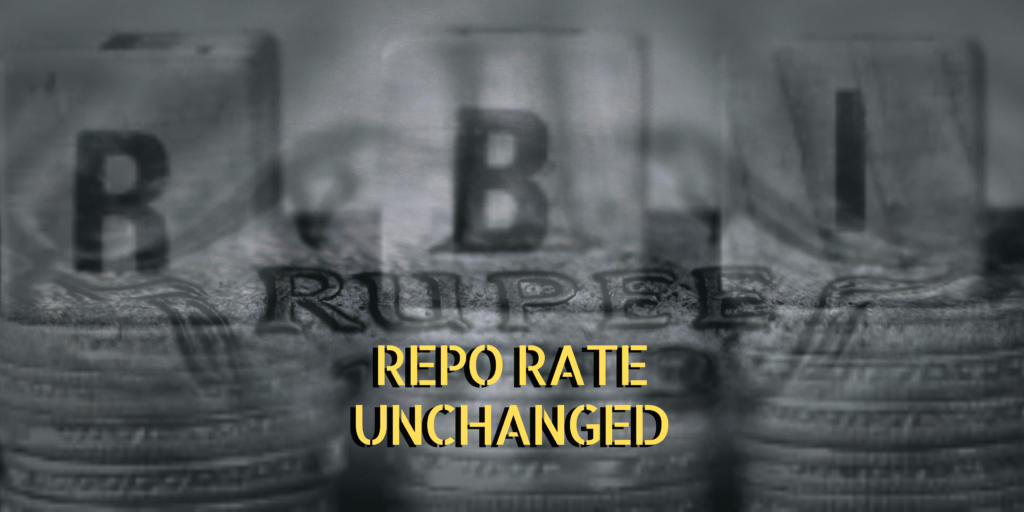
The repo rate is the interest rate at which the Reserve Bank of India (RBI) lends money to commercial banks. It directly influences the interest rates banks charge on loans, thereby affecting the EMIs paid by borrowers. RBI has maintained the repo rate at 6.50% since last year, reflecting a cautious approach in balancing inflation control and economic growth. Here’s an in-depth look at how this decision affects our daily lives and what we can anticipate in the future.
Immediate Effects on Daily Life
- Borrowing Costs When the repo rate remains unchanged, interest rates on loans such as home loans, car loans, and personal loans generally stay stable. This means borrowers will not see an increase in their monthly payments, providing financial predictability and stability for households and businesses. Consistent borrowing costs also encourage new loans, stimulating consumer spending and investment.
- Savings and Investments The interest rates on savings accounts, fixed deposits, and other savings instruments are influenced by the repo rate. With no change in the repo rate, banks tend to keep the interest rates on deposits stable, impacting savers who rely on interest income from their deposits. This stability can be beneficial for those planning long-term savings or investments, as they can predict their returns more accurately.
- Inflation Control A stable repo rate is a tool for controlling inflation. The RBI uses the repo rate to influence borrowing costs and liquidity in the economy. By keeping the rate unchanged, the RBI aims to keep inflation within its target range, ensuring that the prices of goods and services do not rise too rapidly. This helps households manage their budgets more effectively, although persistent inflationary pressures can still affect purchasing power.
- Consumer Spending Stable interest rates can boost consumer confidence and spending, especially on big-ticket items like homes and cars. When borrowing costs remain predictable, people are more likely to make significant purchases, which can stimulate economic activity and growth.
Broader Economic Implications
- Economic Growth:
- Support through Low Borrowing Costs: By keeping the repo rate unchanged, the RBI signals its commitment to supporting economic growth. Lower borrowing costs stimulate business investments and consumer spending, which are critical for economic expansion, particularly during the post-pandemic recovery phase.
- Balanced Approach: The RBI’s policy aims to support medium-term growth prospects while keeping inflation expectations anchored. This balanced approach fosters a stable economic environment conducive to sustainable growth.
- Sectoral Impact: Lower interest rates benefit various sectors, including manufacturing, housing, and infrastructure, by reducing the cost of capital and encouraging investment. This, in turn, generates employment and income, contributing to overall economic prosperity.
- Liquidity Management:
- Ensuring Financial Stability: The RBI actively manages liquidity to maintain stability in financial markets. This involves conducting operations like fine-tuning repo and reverse repo actions to balance liquidity in the banking system.
- Orderly Market Conditions: Effective liquidity management ensures orderly market conditions, preventing excessive volatility. Stable financial markets are essential for economic stability and investor confidence.
- Supporting Monetary Policy Transmission: Managing liquidity effectively supports the transmission of monetary policy actions, ensuring that changes in the repo rate effectively influence lending rates and overall economic activity.
- Crisis Management: During periods of financial stress or crises, the RBI’s liquidity management measures play a crucial role in ensuring the smooth functioning of financial markets and maintaining confidence in the banking system.
Future Expectations of Repo Rate
- Inflation Trends:
- Stable Inflation within Target Range: If inflation remains within the target range set by the RBI, typically around 4% with a tolerance band of +/- 2%, the central bank is likely to maintain the repo rate unchanged. This stance supports economic growth by keeping borrowing costs low.
- Rising Inflation Concerns: Should inflation rise significantly, exceeding the RBI’s comfort zone, the central bank may consider increasing the repo rate. This move aims to curb spending and prevent inflation from escalating further. The RBI remains vigilant and ready to adjust rates if necessary to maintain price stability.
- Economic Recovery:
- Robust Economic Growth: A robust recovery characterized by strong GDP growth and improving economic indicators might prompt the RBI to gradually raise the repo rate. This action helps prevent the economy from overheating and maintains sustainable growth.
- Sluggish Economic Recovery: Conversely, a slower economic recovery may lead to an extended period of unchanged repo rates or even a rate cut. Lowering rates stimulates borrowing and investment, fostering economic activity and recovery.
- Global Economic Conditions:
- Impact of Global Factors: The RBI closely monitors global economic conditions and the monetary policies of other central banks. Changes in global economic stability, such as geopolitical events or shifts in global financial markets, can influence the RBI’s decisions on the repo rate.
- Flexible Monetary Policy: The RBI’s approach remains flexible to adapt to these external factors. For instance, changes in global interest rates or financial market trends may prompt the RBI to adjust its policy stance to maintain domestic economic stability.
Conclusion
The RBI’s decision to keep the repo rate unchanged has far-reaching implications for daily life and the broader economy. Stable borrowing costs and interest rates on savings, along with controlled inflation, contribute to economic stability and consumer confidence. As the RBI continues to monitor inflation and economic growth, future rate decisions will be guided by the evolving economic landscape, both domestically and globally.
Source: (RBI website) (RBI website)
For further details, you can refer to the official Monetary Policy Statement and the RBI’s Press Releases.

